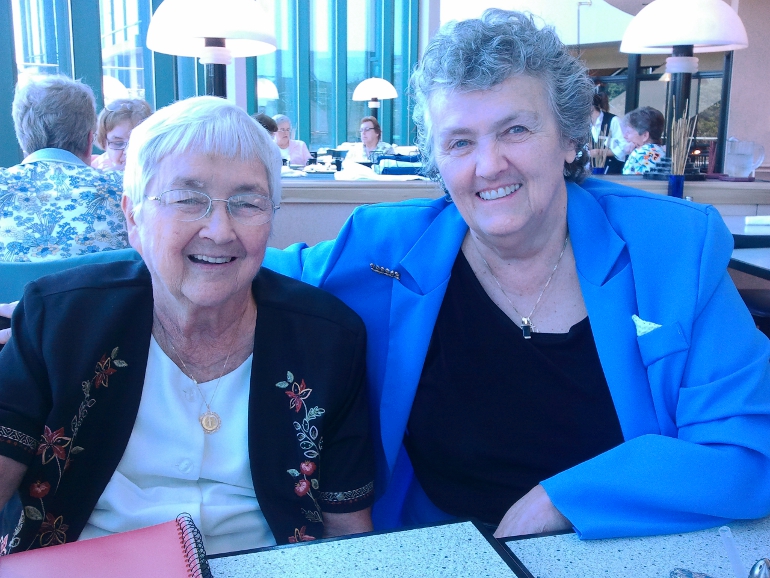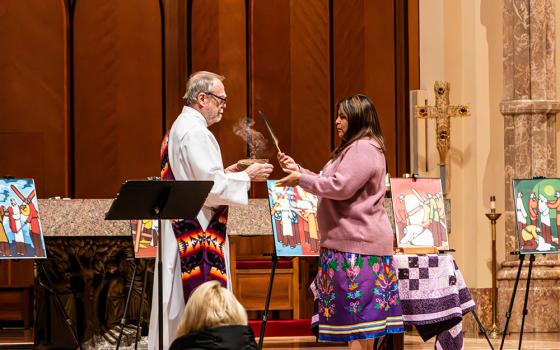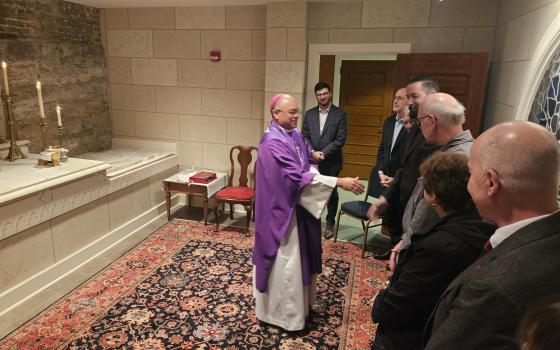
Past presidents of LWCR: Mercy Sr. Theresa Kane and Benedictine Sr. Joan Chittister (Joshua McElwee)
ST. LOUIS -- As representatives of Catholic sisters from across the country gathered here Tuesday for a meeting expected to formulate a formal response to harsh critique from the Vatican, current and past presidents of the Leadership Conference of Women Religious met in closed session to share experiences and lay a foundation for that response.
The meeting, which was attended by about 20 women and lasted just over two hours, was full of great energy and feelings of solidarity, several of the women who attended the session told NCR. But they also expressed feelings of uncertainty because of questions left unanswered.
The overall opinion of the group was that the LCWR could not unconditionally accept the Vatican’s mandate that the leadership conference reform its statutes and structures but neither did the group want to walk away from the canonical structure of the LCWR.
The leaders hope to find a middle path, NCR was told, but that they also want to give the Vatican a firm expression of how they understand themselves as religious, suggesting that the sisters do not “necessarily” need to be part of formal church structures.
One former LCWR president said some in the room had asked bluntly, “Why don’t we drop out? Why don’t we walk away?”
“I don’t think they’re seriously saying ‘Let’s walk away,’ but they’re raising those questions,” said Mercy Sr. Theresa Kane, who was LCWR president in 1979.
“So those questions were raised. And they’re going to be raised this week as possible alternatives, with nobody putting a judgment on any one of them,” she said.
According to Kane, those questions and sentiments reflect what the current LCWR leadership has heard in the group’s regional meetings in the months since the Vatican’s critique.
LCWR is composed of 15 regions spanning the country. Following the Vatican critique, the group hosted meetings of its members in each of those regions.
Airing of those questions is expected to start formally Wednesday, when LCWR begins a number of closed-door "executive sessions" where the group’s members are to meet and discuss the matters at hand.
The critique of LCWR, which was first released April 18, came from the Vatican's Congregation for the Doctrine of the Faith. Among its criticisms, the congregation identified a "prevalence of certain radical feminist themes incompatible with the Catholic faith" in the group's programs and "corporate dissent" in the group regarding the church's sexual teachings.
In a statement June 1, LCWR's national board criticized the Vatican's move, saying it was "based on unsubstantiated accusations and the result of a flawed process that lacked transparency."
According to the Vatican's mandate, LCWR is to place itself under the authority of Seattle Archbishop Peter Sartain, who is to serve as "archbishop delegate" for the group and is to be assisted in that role by Bishop Leonard Blair of Toledo, Ohio, and Bishop Thomas Paprocki of Springfield, Ill.
A key part of Tuesday’s session among past and present LCWR presidents came when Benedictine Sr. Joan Chittister, who was president of the organization in 1976, read selections from a document she had written in 1980, reflecting on her experience with the LCWR from 1971 to 1980.
Chittister said she had forgotten about the document and only recently rediscovered it. It bears an eerie resemblance to the issues that confront the women’s leadership conference today.
Chittister writes about learning that Vatican’s congregation for religious was receiving and reviewing reports, sometimes even tapes, of talks she and other women leaders had delivered.
At one point, she writes, “I knew with a horrible, oppressive feeling that we were being watched, but not talked with; observed and censuredt but not related to.”
“That has been my experience that my years with LCWR have confronted me with most … a sense that I stand like a fly on a pin-head someplace, talking what are important questions to us and being observed from a superior position by someone with a fly-swatter who does not necessarily value what I’m saying or what I am,” Chittister wrote in 1980.
Speaking to NCR Tuesday, Chittister said the document was a reflection she had done after a retreat she had hosted in 1980 for former LCWR leaders.
As part of that retreat, Chittister said, she had invited each of the former leaders to record their own reflections. Those documents, including her own, Chittister said, then “sat on a shelf, as life went by for years.”
She said she told the current LCWR leadership she wanted to present her reflections now, telling them, “I think it may have something to do with what you’re talking about.”
In that reflection, Chittister expresses disappointment about meetings between Vatican and U.S. church officials and U.S. women religious throughout the 1970s.
At one point, Chittister writes in the reflection that even then she was asking whether women religious should live outside formal church structures.
She writes that following the Third Inter-American Conference of Religious, held in Montreal in 1977, she “saw we did not have time to keep playing official Church games much longer; that the function of a Religious was to be a Religious.
“It is only recently that I’ve come to the point where I can say that the function of a Religious is to be religious, not necessarily to be canonical,” she continues.
Chittister references one LCWR meeting of the time, in which she says, “we were touching the real agenda: whether or not woman was a thinking, acting, doing person in the Church. And we were touching the second one: what had priority to us, their [agenda] or the unity of the Conference itself?”
Chittister also says that in conversations at the time with bishops, specifically citing the Vatican’s Congregation for Religious, LCWR members found themselves in a “faith and loyalty trap.”
“In other words,” writes Chittister, “they told us that though we might question certain things ourselves, we could never say them in public. That was to be disloyal to the Church. That was some kind of a sin against faith.”
Later in the document, Chittister frames that “trap” as a “Catch 22” of “whether or not we could be individuals and speak if we were in the LCWR, or if the LCWR itself was permitted to speak or to raise any questions which …’ had already been decided.’”
Chittisters continues that as she is writing the letter, she “can feel the knot in my stomach all over again -- the notion of being nobody in the lowest possible way, the feeling that … so much water is dropping on a rock but it is dropping a drop at a time, and my stomach isn’t sure that I can wait that amount of time.”
Chittister also recalls liaison meetings between members of the U.S. bishops’ conference and LCWR, where she says she felt a sense of despondency about the hopes for some sort of understanding between the two groups.
“In the liaison meetings I remember trying to reach out,” she writes. “I remember knowing that when there were five of them and five of us that at least it was a personal conversation; but I also remember feeling very strongly that …we would put some things on the tables and then we would be listened to politely and they would all go away and the next year we would have a new group there with the same old agenda. It, too, would disappear with no advancement in action of their concerns.”
Closing her letter, Chittister presents four “issues and events” that, she wrote in 1980, “remain in consciousness to me.”
- What she calls a tension between the concern of “unity in the church” and the awakening of female “consciousness:” “Once you have a consciousness of new order of creaturehood … continually suppressing that for the sake of institutional or organization fragility… is extremely oppressive.”
- The question of whether continuing dialog with the bishops was helpful: “I’m still not sure that continued regular yearly self-revelation is productive, or is simply alerting even more to the effect their adverse use of … power … effects us.”
- What she calls “dealing with the pain that comes from found but lost personhood; not being able to participate in much except administrative dissent that seems to be the women’s ministry in the Church at this time … their ability to see us but not see us, and to make us non-persons.”
- That LCWR should be a “support system” that is “in a sense a small quiet voice in their own camp, but not in their own camp.”
“Where should we go? What is really madness?” Chittister concludes the letter. “[Those] may be questions that are answered much sooner that I myself would choose.”
The LCWR gathering officially kicks off Tuesday night, with an introduction by St. Louis Archbishop Robert Carlson. A centerpiece of this year's LCWR gathering is to take place Wednesday in a keynote address by Barbara Marx Hubbard, an author known for her advancement of a worldview called "conscious evolution."
Also on the agenda of the LCWR assembly are NCR publisher Tom Fox and NCR columnist Jamie Manson, who will share a panel discussion Aug. 9 with Sr. Jennifer Gordon, a member of the Sisters of Charity of Leavenworth, Kan., to discuss "Religious Life in the Future: What Might It Look Like?"
During the assembly, LCWR will also hold its annual transition of the group's top leaders -- their president-elect, president and past president -- who govern LCWR collaboratively with the group's secretary, treasurer and executive director.
During a formal ceremony set for Friday afternoon, the current head of the group, Franciscan Sr. Pat Farrell, will move to the position of past president, while Franciscan Sr. Florence Deacon, currently LCWR's president-elect, will become its president.
Deacon, who is also the congregational leader of the Sisters of St. Francis of Assisi based in St. Francis, Wis., previously served at the United Nations as director of the New York office of Franciscans International, a nongovernmental organization that lobbies for justice issues.
[Joshua J. McElwee is an NCR staff writer. His email address is jmcelwee@ncronline.org.]
NCR will be reporting on the LCWR assembly all week. Previous reports:
- Outside LCWR meeting, victims allege abuse by sisters, Aug. 9
- Keynote: LCWR 'seed bed' for 21st century, Aug. 8
- LCWR 'gathers collective wisdom' of members to discern next steps, Aug. 8
- LCWR past presidents reflect on Vatican mandate, Aug. 7
- LCWR to determine course at next week's annual meeting, July 31
For related commentary see:
- The Vatican, LCWR, and Definitions of Dialogue By Kevin Aschenbrenner
- What LCWR teaches us about church leadership By Jamie L. Manson
- Are these sisters dangerous women? By Patrick T. Reardon
- The Second Vatican Council has already made us free By Robert Blair Kaiser




